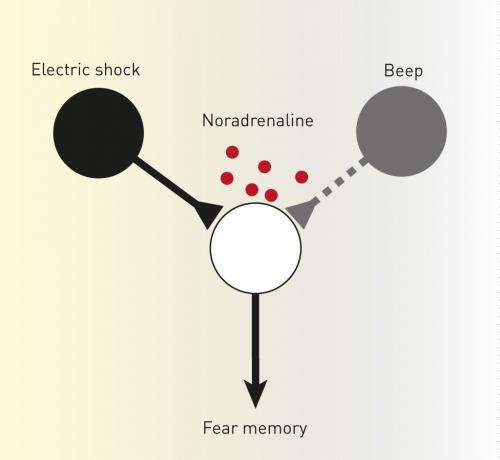Two mechanisms work in tandem to form memories of frightening events

The formation of memories of fearful experiences involves not only changes in brain wiring, but also the action of a chemical known as noradrenaline, shows a study led by researchers from the RIKEN Brain Science Institute. This understanding has enabled the researchers to artificially implant a fear memory in rats.
A type of neural plasticity called 'Hebbian plasticity' has long been linked with memory formation. According to Hebbian theory, when two connected neurons fire together repeatedly, they become associated in a way that causes one to facilitate the firing of the other. This explains, for example, how rats soon learn to fear a beeping sound if it occurs in conjunction with a mild electric shock.
"What has really been missing, however," says Joshua Johansen from the research team, "is a test of Hebbian plasticity in the actual working brain."
So Johansen and colleagues from RIKEN and other institutions investigated the mechanisms underlying the way rats learn to fear auditory stimuli paired with mild electric shocks. They concentrated on 'pyramidal cells' in a brain structure called the amygdala. These cells are known to be important in fear-memory formation, and also to receive inputs from many other neurons, including ones that respond to sound.
The team showed that a Hebbian process was indeed present, with neurons responding to the auditory stimuli firing simultaneously with pyramidal cells responding to the electric shock. "We have shown that the conditions necessary for Hebbian plasticity to occur are present," explains Johansen.
However, they discovered that another process is also essential for fear memories to form. Using a technique called optogenetics, by which nerve cells can be activated with light, the researchers showed that artificially activating the pyramidal cells to simulate the electric shock in concert with an actual auditory stimulus did not result in a fear memory. They discovered that a fear memory was only produced when accompanied by a shock, even a mild one.
The researchers explain that the electric shock not only excites the pyramidal cells, but also causes the release of a neuromodulator chemical, noradrenaline, which also acts on the pyramidal cells (Fig. 1). Johansen's team then showed that noradrenaline needed to be present for a fear memory to be laid down.
Armed with this knowledge, the team succeeded in inducing a fear memory without an electric shock. "We were able to artificially implant a fear memory based on a better understanding of the plasticity mechanisms," says Johansen.
More information: Johansen, J. P., Diaz-Mataiz, L., Hamanaka, H., Ozawa, T., Ycu, E., Koivumaa, J., Kumar, A., Hou, M., Deisseroth, K., Boyden, E. S., LeDoux, J. E. "Hebbian and neuromodulatory mechanisms interact to trigger associative memory formation." Proceedings of the National Academy of Sciences USA 111, 51 (2014). DOI: 10.1073/pnas.1421304111















